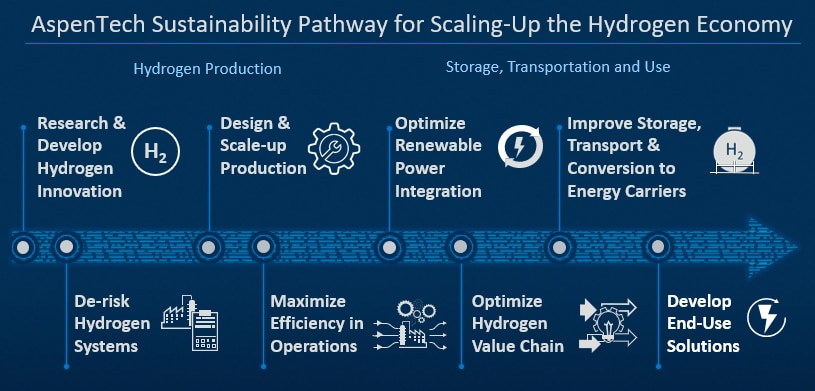There is huge interest and corresponding level of innovation activity in the key opportunity areas of the Hydrogen Economy today. The opportunity areas include green and low-carbon hydrogen production, hydrogen storage and delivery to market, “carrier” fluids, and end uses (such as fuel cells and hydrogen/natural gas mixtures). This is driving very strong investments in the sector, which in turn has driven capital project activity globally. There are hurdles.
Bill Gates, in his recent book on climate solutions and breakthroughs talks about the “Green Premium.” (In other words, that the world is facing paying more for energy that is green, and that extra cost must be eliminated.) Gates argues that it will be through trillions of dollars of investment that the innovation and breakthroughs will accelerate, reducing and eliminating the Green Premium. For hydrogen, those levels of investment are expected. Today, hydrogen activity is being jump started through government incentives, favorable regulations and taxes, and research subsidies.
Hydrogen is expected to account for 20% of the world’s carbon abatement by the year 2050 according to a recent report by McKinsey and Company. According to a May 2022 analysis by H2 Tech Magazine, there are 930 hydrogen projects globally, 47 of which are what the Hydrogen Council calls “Giga-Scale” projects. Today, the world production of hydrogen stands at approximately 100 million metric tons (MT) per year. Most of that is for “captive use” in refining and chemical processes. The World Bank projects the number will grow by more than 9% per year through 2030, with world production of hydrogen reaching 500-680 MT per year by 2050.
This sounds good but why are some of the largest initiatives moving slowly? As long ago as 2003, the US and Europe agreed to collaborate on accelerating the hydrogen economy. It finally is becoming reality. What are the remaining hurdles to overcome to scale up the global hydrogen value chain and realize the projects from the World Bank, Hydrogen Council, International Energy Agency (IEA), McKinsey and others?
The biggest of these hurdles is the economics of hydrogen production, delivery and use. Today, according to the International Renewable Energy Agency (IRENA), hydrogen energy is 2-3 times more expensive than fossil energy (not counting the cost of carbon), and hydrogen pipelines are 10-50% more expensive than natural gas and oil pipelines.
Digital technology will provide the “magic bullet” that will level the playing field, and it can do so very quickly for those players who embrace it. AspenTech has developed a “sustainability pathway” for the hydrogen economy that makes the key digital technologies easy to adopt for supporting innovation, execution and scaling of hydrogen projects across the value chain, from renewables to hydrogen production to storage and delivery of hydrogen to end use.

Here are six steps to adopting digital technology in the hydrogen economy:
- Systems-level analysis of a hydrogen project. Defining the best choices in the investment stage of hydrogen projects is complicated by many alternative pathways, technology choices, new technology risks and weather variability. Digital technology will have one of its biggest impacts here in making the right choices to balance scale, risk and innovation. AspenTech has built a hydrogen economy sample model into our Aspen Fidelis risk and availability systems analysis system. We are already working with several groups who are at the early stages of large hydrogen projects to help take a fact- and risk-based approach to making technology, configuration, location and process decisions at the earliest stages of projects.
- Digital twin modeling of hydrogen production to reduce capital costs by 75%. In proven industrial areas, digital twins are a nice to have. In the hydrogen economy, digital twins are an essential engineering, estimating and project tool that will enable (a) evaluation of thousands of alternative design choices to select the leading candidates both in terms of productivity and efficiency, but also in terms of optimizing the overall process beyond the core technology components (such as electrolysis); (b) rapid evaluation of costs and economics related to alternatives; (c) virtual mirroring and constant performance evaluation of new technologies, such as electrolysis systems for green hydrogen and integrated reforming and carbon capture and storage systems for low carbon (blue) hydrogen; and (d) ongoing feedback of early operating modules and improvement of follow on modules.
For hydrogen, digital twin feedback will be crucial in the expected progressive implementation strategy. AspenTech provides uniquely accurate and complete modeling approaches for green and blue hydrogen (electrolysis, reforming, ammonia production and associated carbon capture). We’re also working with Emerson Electric to link AspenTech’s rigorous models with Emerson’s operator training (OTS) digital twin and augmented reality operator training, which will accelerate training and startup of hydrogen projects. Air Products, a world leading hydrogen supplier, recently published a case study describing the use of AspenTech digital twin models across their network of hydrogen plants and pipelines throughout the U.S. gulf coast. That case study documents more than $1M in annual cost reduction in operations, as measured in one of the 15 plants managed with the help of these models.
- Optimization of renewable power, storage and electrolysis to increase hydrogen production load factor and reduce operating costs by 10%. There is a lot of focus on capital costs associated with hydrogen electrolysis, however reducing the operating costs for hydrogen production is also crucial. AspenTech’s OSI business provides an industry-tested and scalable distributed energy resource management (DERMS) and microgrid solution that can optimize renewable power arrays together with power storage, optimizing delivery of power for electrolysis and carbon capture. Combined with the Aspen Utilities software that optimizes utilization of power in processes such as green and blue hydrogen, this provides a comprehensive opportunity to reduce energy-based operating costs by 10% or more. This approach has attracted considerable interest from several hydrogen projects currently in design.
- Monitoring, measuring and modeling hydrogen storage and transport for safety to achieve 100% availability. Dr. Robert Socolow, co-author of the 2003 Hydrogen Economy Blueprint, believes that safety is an important concern for rapid adoption of the hydrogen economy, both for hydrogen delivery and for hydrogen end use. AspenTech’s modeling solutions can rigorously model behavior of low temperature hydrogen to ensure safety envelopes in the engineering of systems. The AspenTech OSI Continua pipeline monitoring and management solution will provide operational awareness of the reliability and integrity of transport systems. We’re also working with Emerson Electric here in linking AspenTech’s rigorous models with Emerson’s advanced measurement technology to monitor, detect, and prevent hydrogen leaks.
- Optimize the hydrogen value chain. The overall economics of hydrogen will be dependent on a value chain that in most cases will cross multiple company boundaries. The Aspen Unified PIMS planning solution is an ideal tool to both design and manage the various pathways along such hydrogen value chains. AspenTech has built hydrogen unit models into the PIMS system for that purpose, and we’ve tested on models of the California and northeastern US nascent hydrogen economy value chains. In conjunction with systems level modeling (described in step one above), these two digital solutions together will enable hydrogen economy players to make the right decisions in investing across the hydrogen economy, both in selection of process technologies and in making decisions with respect to value chain paths, such as pipelines, carrier fluids, redundancies and the like.
- Improve and optimize hydrogen end use for economics and safety to ensure market acceptance. The same rigorous and accurate models that are used for hydrogen electrolysis technology innovation also provide high value in the innovation and engineering stages for scaling the hydrogen fuel cell market. Doosan Fuel Cell is only one of more than 15 fuel cell and automotive companies that are using AspenTech process modeling in their fuel cell engineering activities. Digital twins will be crucial in accelerating the improvement of fuel cells from version to version as usage increases.
In summary, digital technology is already, and will continue to be, a strategic element in reducing cost across the hydrogen value chain, accelerating scaling and speed of implementation, and ensuring the safety and reliability of hydrogen solutions. We will be interested in engaging in discussions and workshops with your organization to accelerate your efforts and opportunities in the hydrogen market.
.svg?la=en&hash=41CA47BC884359427B7CB06E93598E59)



Leave A Comment